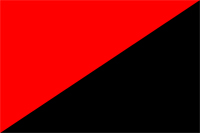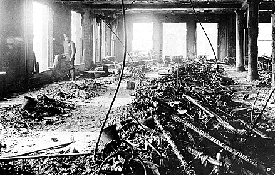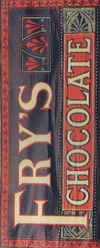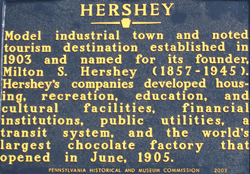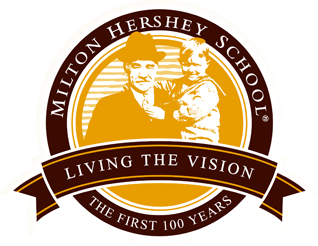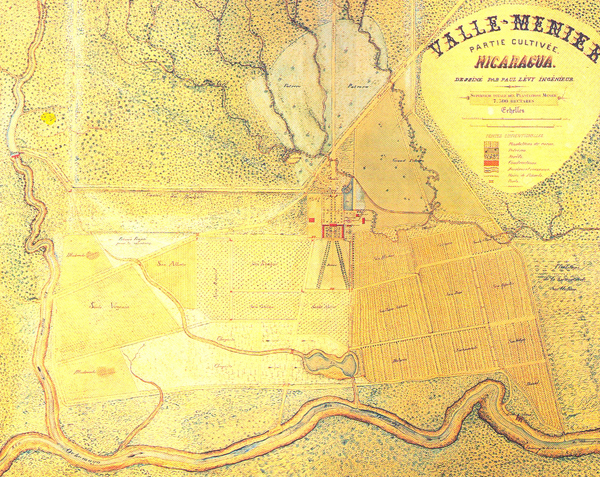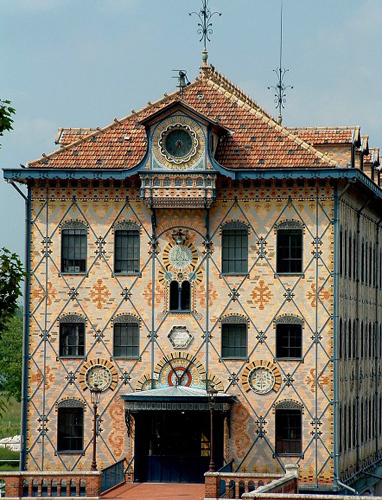“Good” chocolate, however, possesses health benefits & a proud tradition of social healing.
Indeed, whom do we have to thank for universal education, health care & pensions? Marx & Engels? FDR? Sweden? Nope, in some measure… chocolate.
A unique group of chocolate business leaders built special towns around their factories, providing amenities that later became standard in modern advanced nations.
The good works of Quakers, Amish, Catholics & conscientious people everywhere
Quaker involvement with chocolate stems from their humble beginnings as a tiny minority in England. They cut against the orthodoxy of the official Anglican Church because their belief system held no need for priests & sacraments. Instead they pursued a Lutheran-like experience with God, direct & unmediated, that cast them as “nonconformists”… & thus persecuted.
Indeed, the very word ‘Quaker’ was originally hatched as a derogatory term. They called themselves simply Friends or Friends Society. ‘Quaker’ meant the same as ‘cracker’ but the Friends flipped & embraced it into a term of endearment much the way hip-hop MCs inverted ‘nigga’.
That they paid a price by being banned from attending universities & barred from holding public office meant their beliefs relegated them to the lower strata of business & commerce, forced into setting up grocery shops that would inadvertently come in handy when the time arrived to sell chocolate. Apt parallels to American Jewry, who also began very modestly, clustered amidst a sea of Christians on the Lower East Side of Manhattan along their path to achievements in the arts & sciences beginning with Mordecai Manuel Noah onward.
Like others so scorned & oppressed, Quakers overcame to wildly succeed.
One avenue stayed open to them – medicine – learned at that time thru apprenticeship rather than the university. Chocolate at its root, after all, passed thru a medical filter to enter wider European culture, starting with the Jesuits who initially operated as botanists as well as missionaries in the New World. Cacáo probably first attracted Jesuits for the healing properties of its extracted cocoa butter. So they set up infirmaries & pharmacies for profit to finance their religious activities. Back in Europe they carried chocolate around Spain, while visiting the Vatican, & traveling to Catholic France.
From there, the medical-chocolate association became legion:
In 1761, Quaker physician Joseph Fry purchased the Churchman Apothecary & with it a royal patent for a machine he used to concoct a number of self-taught chocolate remedies.
Pharmacist Jean-Antoine Menier, a medic in Napoleon’s Grand Armée, opened a chocolate factory on the outskirts of Paris.
Coenraad van Houten – a chemist, an allied field to medicine – patented the hydraulic press for separating cocoa butter from cocoa mass, leading to a cascade of further developments.
Ditto chemist Henri Nestlé –- who had a hand in the first Milk Chocolate bar.
Links between physicians & chocolate continue right into the modern era – the late Dr. Robert Steinberg, co-founded Scharffen Berger in 1997.
********************
Their medical backgrounds in tandem with their grocery / retail networks offered Quakers an opportunity. Valued goods that fit their beliefs & lifestyle were paramount because they saw God in everyone before they saw profits from someone. Each person, regardless of faith, deserved respect. Along with equality, they shared values of peace & simplicity; basically New Age Christians… everything but crystals since that might violate the simple frugal life.
A feeling that alcoholic abuse, especially gin in the working class pubs, caused hooliganism & even violence ran rampant among them. While never calling for a ban – Quakers are a bit like herding cats, very independent & freethinking, nonconformists after all, without creeds or doctrines per se – alcohol still disturbed them.
So, if you’re a temperance-minded pacifist, ya don’t drink, don’t smoke, can’t open a distillery or a munitions depot, & joining a rock band was still a century away in hitsville UK, what else can you do? That pretty much left sex & chocolate.
Chocolate presented an ideal antidote. A healthful & nourishing beverage, it had yet to be molded into an eating bar (Quakers would change that too) so cocoa’s benefits doubled by having to boil the water needed to prepare it at a time when clean drinking water ws scarce.
Moreover it dovetailed into their business activities. Chocolate actually presented them with an advantage over other retailers, for Quakers had already earned a reputation for honesty & reliability, selling pure goods free of lead or brick dust… no small concern when contaminated goods were frequently the rule rather than the exception, especially chocolate which could easily be adulterated. Plus, Quakers stood amongst the first to set a firm price. Before them, endless bartering & haggling took place. They marked each item at one price – the fair & right price – to eliminate buyers’ remorse.
This ethic for equality & justice ran parallel with their quest for social reform.
Frenchman Henri de Saint-Simon coined the term ‘socialism’, a yearning that hung in the air in the 19th century, as a reaction against brutal industrialization. Factory life meant generally impoverished drudgery & worse…. an industrialized hell filled with child labor, regimented work, filthy conditions & safety code violations. That’s if there were any codes. A fact brought home one night after the tragic fire inside NYC’s Triangle Shirtwaist Factory where 146 people, mostly young women, burned to their deaths, unable to escape because shop managers locked them in to keep anyone from taking breaks.Advocates viewed Socialism as the height of the Enlightenment, a political philosophy marrying science & technology with economic progress. Quakers blended this with a good dose of Benevolent Capitalism. Their nonconformist ways called for faith-based initiatives without the aid of coercion (what Rousseau termed “habits of the heart”), putting the burden of responsibility – whether for salvation or climbing the social ladder – on the individual. ‘Pull yourself up by the bootstraps’ & ‘get on with it’ more than any welfare state drove them to take matters into their own hands.
Given where they found themselves & their own social circumstances, what better way than to build chocolate plants modeled on these principles.
A string of quasi-socialist firms followed. Most set up sparkling new facilities of super clean hygiene outside urban confines on open tracts of land & fresh air scented above all with chocolate. Idyllic settings, in the age of Romanticism, steeped in Quaker values infusing hard work with a shared sense of purpose. Worker-happy villages where everyone knew they had it good.
The “workers-paradises” included these developments —
Early 1800s – Quaker Joseph Storrs Fry, son of Dr. Joseph Fry, mechanized the process for grinding cocoa beans using the Watts steam engine – effectively the first manufacturer to introduce factory methods to the industry. Paired with van Houten’s hydraulic press for extracting cocoa butter in the form of liquid oil, the Frys eventually add greater butter back into the chocolate mix, creating higher viscosity (re: better flow) for what’s known as ‘chocolate liquor’ (non-alcoholic of course) that could easily be poured & molded into… the first chocolate bar in 1847. This invention ruptures with the past. Prior to that, cocoa served as a sipping beverage only, a lazy dainty teatime affair. No longer a powder stirred in hot water, now people just crack the wrapper to ‘break ‘n bite’ for ‘eating chocolate’… right in tempo with a world accelerating at the speed of locomotives & machines. Granted, these initial bars cut a rough, coarse, gritty affair – more sugar than cocoa mass, still yet to be refined by the conching process – but they blazed the trail that would later lead to that super-suave velvet texture in the anno mirabilis of 1879.That very same year (1879) the Cadbury’s, another Quaker family, move their chocolate operations to Bourneville near Birmingham England in the West Midlands. Cadbury’s delivers chocolate with a spoonful of radical activism: schools, housing, parks, a community pool (imagine that), pensions &, of course, bibles. Where American Evangelicals place one in every hotel room, Quakers hand them out to workers, especially newlyweds. The company also provided medical care, including dental, based on the adage ‘a healthy workforce is a productive workforce’.
1862 – Rowntree of Kit Kat™ wafer fame starts up operations. Some 40 years later it breaks ground for a model factory in the suburbs of York, England. Rowntree establishes both higher quality standards & improved quality of life. After a visit to Ireland, the potato famine there left an impression on Joseph Rowntree so he responds by upping the ante. In addition to a library, free education, social welfare, medical coverage & pensions, he leaves a substantial charitable trust for philanthropic works that survive him long after his death. 1893 – Milton Hershey, of a Mennonite sect that split off from the Amish, goes way beyond the vision of the English Quakers for his utopia in Hershey, Pennsylvania. His became a company town thru & thru – ‘Chocolatetown USA – the Sweetest Place on Earth’. A pre-cursor to Disney’d theme parks decked with now-bygone Main Streets fronting banks, dept stores, theaters, schools, churches, hospitals, museums, golf courses, night clubs, hotels, gardens & an amusement park sporting the all-world Wildcat roller coaster (complete with a cemetery naturally) – the model that auto mogul Henry Ford would try to transport to the Amazon jungle calling it Fordlândia.In the spirit of Rowntree, Milton Hershey died penniless, leaving all his fortune in a trust for underprivileged youth from all walks & stripes to attend The Milton Hershey School – ‘Opening New Doors for Children in Need’ – gifted with one of the largest endowment funds for any educational institution be it high school or college.
All these found inspiration in the paragon laid down by Émile Menier, son of Dr. Jean-Antoine Menier. A family of French Catholics, the Meniers moved to Noisiel, outside Paris, in 1830, arguably the first full-fledged chocolate factory. Over the years, the company under Émile’s leadership expanded its grounds & plants, affording workers electricity, telephones (unheard of at the time) & early retirement, plus a senior-citizens center. He also built a town hall in which a member of his family would serve as mayor, uninterrupted, until 1959 as if they owned the place – which of course they did.
Émile’s lasting mark includes tapping Jules Saulnier to design an iconic building of Industrial Architecture. A masterpiece of wrought iron & brick, the Menier headquarters built in 1872 spires up a cathedral to chocolate.
He was just beginning.
Émile drove beyond the 4 walls to the wider world, to the commonwealth of humanity. Concerned about labor’s welfare, he acquired his own cacáo grove in Nicaragua to redress working conditions on the ground where it grows, & sugar-beet fields in France because of cruelty on sugar plantations in the tropics.
Hershey’s followed his lead. Dairy for The Great American Chocolate Bar came from cows grazing right outside the town on Pennsylvania’s rolling hills, & sugar from Hershey’s own plantation in Cuba where he softened that harsh environment by furnishing electricity & running water for workers – an unprecedented amenity for the era.
Likewise, Cadbury, who was once called on the mat for purchasing cocoa from Portuguese São Tomé, a former barren-island-turned-slave colony. In keeping with their Quaker traditions, Cadbury eventually boycotted any cocoa from those plantations tended by indentured labor until conditions improved.
Conscientious Christians everywhere (as few as they might’ve been given Nietzsche’s criticism that the last true Xian died on the cross) found slavery repulsive. Quakers in particular marched in the vanguard of its abolition & for human rights.
The 1688 Germantown Settlement Anti-Slavery Petition signed in William Penn’s Philadelphia -refuge for people suffering religious persecution & intolerance, stands testament to their early struggles on behalf of the enslaved. American polymath Ben Franklin sat on those Quaker abolition committees.
Quaker members dominated the British Committee for the Abolition of Slavery but, again, as nonconformists, laws prevented them from holding any seats in Parliament. So they circulated their petitions, starting in 1783, thru sympathetic proxies. Ultimately their vision came to light & abolition passed, steered by two Anglicans: Thomas Clarkson & British MP William Wilburforce over the objections of violent opponents including, incredibly, Africans themselves.
Almost simultaneously, the likes of William Anderson, David Livingstone & scores of others descended on Africa. The Basel Missionaries, a group primarily of German Christians, went to west Africa to teach industrial trades, hoping to create employment for local communities as a means to an end: converting souls. They built 27 schools for boys & girls, with instruction in masonry, carpentry, & bookbinding. One of their apprentices was blacksmith Tetteh Quarshie, who became the Johnny Cacáo-seed of Ghana.
A shape to all these good works began to emerge, connecting Europe, Africa & the Americas. A Salvation Triangle, writ small, hoping to supplant if not submerge the slave trade of centuries past; its effectiveness, however, always limited by larger realities. Chocolate, once King Kong of all cash crops calling the shots, as it might have during Aztec & even early Spanish empires, was forced to take a back seat to newer rawer politics, difficult times, & torturous histories.
The litany reads –
South America – The Liberator, Simon Bolivar, famously declares “All who served the Revolution have plowed the sea”, leaving in its wake the triple yoke of ignorance, tyranny, & vice;
Oceania / Pacific Islands – nowhere near a workers’ paradise;
Caribbean – improvements tempered by chocolate nipping on the heels of sugar & King Cane, as it’s called, which remains a brutally labor-intensive business;
Africa – then a long ways from becoming the worlds #1 producer where even today cocoa yields a bittersweet dream.
On balance the goodness of their legacy endures however.
Those model chocolate factories created baseline work rules & conditions, gifting pensions & healthcare, sanitation standards & labeling that many continue to enjoy around the world today. Their advancements in production & automation dramatically dropped the price of chocolate, making a once-aristocratic exclusive into an affordable everyday luxury.
And chocolate, an elaborate compound sourcing materials from all over the planet thru a long market chain has played its part in integrating the global economy, helping to build social bridges around the world.
On the downside, the suburban corporate parks that ring urban centers everywhere owe some debt to them as well. Ditto the new ‘lifestyle malls’ across the country & ersatz communities virtually brought from the back lots of a Hollywood set (exemplified by The Truman Show). And their marketing campaigns cemented associations of chocolate with innocence & schmaltz exemplified by Menier’s graffiti girl or Cadbury’s introducing the Valentine box, notions that cacáo was unable to shake & live down until the 21st century when it started regaining its subversive edge.
But above all, they taught that business has an obligation which fostered CSR programs (Corporate Social Responsibility). Problems notwithstanding, Organic, Fair-Trade, Sustainability, et. al., can in some ways trace their roots back to them. As can many watch groups. How would political prisoners free themselves without Amnesty Intl, or how would the Earth fare minus Greenpeace, & disaster victims Oxfam? All Quaker organizations.
For chocolatarians the world over, their influence lingers. The new era bean-to-bar makers, a collective of optimists, idealists, romantics, dreamers, visionaries, & radicals… imagineers who happily pioneer the borders of chocolate… Shawn Askinosie’s ‘stake in the outcome’; Seneca Klassen’s Hawai’ian cacáo venture; Dan Pearson community building in the Amazon; Gianluca Franzoni the Magister Ludi of Chocolate… all kindred spirits of the Meniers, Quakers, & Milton.
The Cathedral of Chocolate: Menier’s Headquarters; Noisiel, France